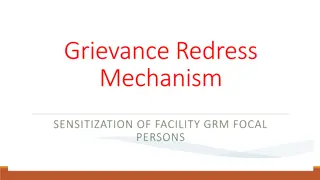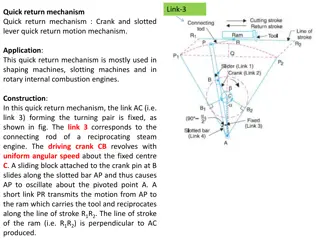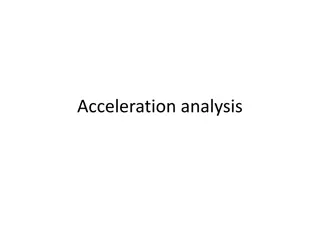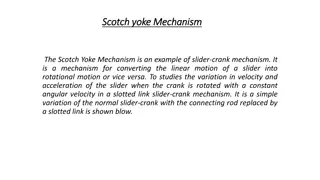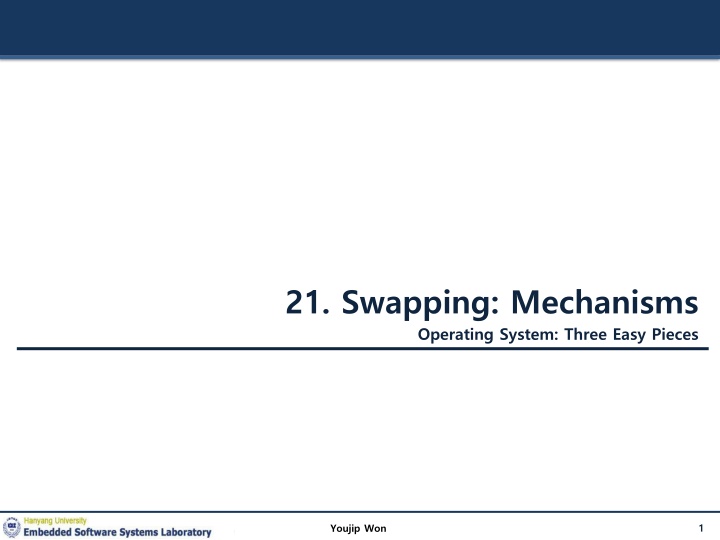
Memory Swapping Mechanisms in Operating Systems
Explore the concepts of memory swapping mechanisms in operating systems, including the role of swap space, page faults, and page replacement policies. Learn how modern systems manage memory hierarchy and leverage disk storage to optimize memory usage.
Download Presentation

Please find below an Image/Link to download the presentation.
The content on the website is provided AS IS for your information and personal use only. It may not be sold, licensed, or shared on other websites without obtaining consent from the author. If you encounter any issues during the download, it is possible that the publisher has removed the file from their server.
You are allowed to download the files provided on this website for personal or commercial use, subject to the condition that they are used lawfully. All files are the property of their respective owners.
The content on the website is provided AS IS for your information and personal use only. It may not be sold, licensed, or shared on other websites without obtaining consent from the author.
E N D
Presentation Transcript
21. Swapping: Mechanisms Operating System: Three Easy Pieces 1 Youjip Won
Beyond Physical Memory: Mechanisms Require an additional level in the memory hierarchy. OS need a place to stash away portions of address space that currently aren t in great demand. In modern systems, this role is usually served by a hard disk drive Registers Cache Main Memory Mass Storage( hard disk, tape, etc...) Memory Hierarchy in modern system 2 Youjip Won
Single large address for a process Always need to first arrange for the code or data to be in memory when before calling a function or accessing data. To Beyond just a single process. The addition of swap space allows the OS to support the illusion of a large virtual memory for multiple concurrently-running process 3 Youjip Won
Swap Space Reserve some space on the disk for moving pages back and forth. OS need to remember to the swap space, in page-sized unit PFN 2 PFN 3 PFN 1 PFN 0 Physical Memory Proc 0 [VPN 0] Proc 1 [VPN 2] Proc 1 [VPN 3] Proc 2 [VPN 0] Block 1 Block 2 Block 3 Block 4 Block 5 Block 6 Block 7 Block 0 Swap Space Proc 0 [VPN 1] Proc 0 [VPN 2] Proc 1 [VPN 0] Proc 1 [VPN 1] Proc 3 [VPN 0] Proc 2 [VPN 1] Proc 3 [VPN 1] [Free] Physical Memory and Swap Space 4 Youjip Won
Present Bit Add some machinery higher up in the system in order to support swapping pages to and from the disk. When the hardware looks in the PTE, it may find that the page is not present in physical memory. Value Meaning 1 1 page is present in physical memory 0 0 The page is not in memory but rather on disk. 5 Youjip Won
What If Memory Is Full ? The OS like to page out pages to make room for the new pages the OS is about to bring in. The process of picking a page to kick out, or replace is known as page- replacement policy 6 Youjip Won
The Page Fault Accessing page that is not in physical memory. If a page is not present and has been swapped disk, the OS need to swap the page into memory in order to service the page fault. 7 Youjip Won
Page Fault Control Flow PTE used for data such as the PFN of the page for a disk address. Operating System 3. Check storage whether page is exist. Secondary Storage 2.Trap 1. Reference Load M i i 6. reinstruction Page Frame Page Frame Page Table 4. Get the page ... ... Page Frame 5. Reset Page Table. Page Frame Virtual Address When the OS receives a page fault, it looks in the PTE and issues the request to disk. 8 Youjip Won
Page Fault Control Flow Hardware 1: VPN = (VirtualAddress & VPN_MASK) >> SHIFT 2: (Success, TlbEntry) = TLB_Lookup(VPN) 3: if (Success == True) // TLB Hit 4: if (CanAccess(TlbEntry.ProtectBits) == True) 5: Offset = VirtualAddress & OFFSET_MASK 6: PhysAddr = (TlbEntry.PFN << SHIFT) | Offset 7: Register = AccessMemory(PhysAddr) 8: else RaiseException(PROTECTION_FAULT) 9 Youjip Won
Page Fault Control Flow Hardware 9: else // TLB Miss 10: PTEAddr = PTBR + (VPN * sizeof(PTE)) 11: PTE = AccessMemory(PTEAddr) 12: if (PTE.Valid == False) 13: RaiseException(SEGMENTATION_FAULT) 14: else 15: if (CanAccess(PTE.ProtectBits) == False) 16: RaiseException(PROTECTION_FAULT) 17: else if (PTE.Present == True) 18: // assuming hardware-managed TLB 19: TLB_Insert(VPN, PTE.PFN, PTE.ProtectBits) 20: RetryInstruction() 21: else if (PTE.Present == False) 22: RaiseException(PAGE_FAULT) 10 Youjip Won
Page Fault Control Flow Software 1: PFN = FindFreePhysicalPage() 2: if (PFN == -1) // no free page found 3: PFN = EvictPage() // run replacement algorithm 4: DiskRead(PTE.DiskAddr, pfn) // sleep (waiting for I/O) 5: PTE.present = True // update page table with present 6: PTE.PFN = PFN // bit and translation (PFN) 7: RetryInstruction() // retry instruction The OS must find a physical frame for the soon-be-faulted-in page to reside within. If there is no such page, waiting for the replacement algorithm to run and kick some pages out of memory. 11 Youjip Won
When Replacements Really Occur OS waits until memory is entirely full, and only then replaces a page to make room for some other page This is a little bit unrealistic, and there are many reason for the OS to keep a small portion of memory free more proactively. Swap Daemon, Page Daemon There are fewer than LW pages available, a background thread that is responsible for freeing memory runs. The thread evicts pages until there are HW pages available. 12 Youjip Won
Disclaimer: This lecture slide set was initially developed for Operating System course in Computer Science Dept. at Hanyang University. This lecture slide set is for OSTEP book written by Remzi and Andrea at University of Wisconsin. 13 Youjip Won






